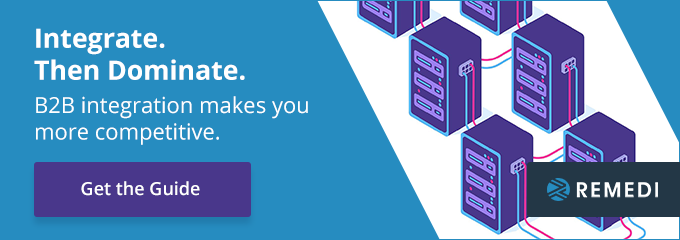
If you’re progressing along the digital maturity spectrum, now might be the time to consider a comprehensive B2B integration suite. What goes into this decision, and why would it be the right choice for your firm?
In this article, we’ll explore what a comprehensive B2B integration suite is, what you should think about when making this decision, and how a comprehensive B2B integration suite can help you.
What Is a Comprehensive B2B Integration Suite?
A comprehensive B2B integration suite is a solution that provides a single platform for file-based, EDI, and application integration. This platform optimizes end-to-end integration processes.
You’ll see a comprehensive B2B integration suite used within a network of trading partners, applications, suppliers, customers, and marketplaces.
What’s the Difference between a Comprehensive B2B Integration Suite and an EDI System?
If you’re using an EDI system and you’ve felt pressure to upgrade to a comprehensive B2B integration suite, you might be wondering what all the fuss is about.
EDI systems are workhorses. They excel at processing large batches of data. Companies across the world use EDI systems to transmit and process critical information. However, there’s a gap between what EDI systems can deliver and what modern businesses need.
“There’s a gap between what EDI systems can deliver, and what modern businesses need.”
That’s where comprehensive B2B integration suites come into play. They use technologies such as APIs to deliver information in near-real time, and they also work with blockchain and IoT.
Additionally, EDI systems can be challenging for onboarding new trading partners. There’s anecdotal evidence that says it can take at least a month to onboard new trading partners into EDI systems. No one’s business benefits when it takes that long to add someone to a business technology system.
“Comprehensive B2B integration solutions can deliver information in near-real time.”
A comprehensive B2B integration suite helps you stay competitive in a challenging business environment. Below, we’ll explore some use cases which show how a comprehensive B2B integration suite delivers value to businesses.
The Decision-making Process for a Comprehensive B2B Integration Suite
The first step in deciding whether a comprehensive B2B integration suite is right for your company is to look at how this technology would benefit the company as a whole.
Use Cases for Comprehensive B2B Integration Suites
There are a number of use cases for comprehensive B2B integration suites. We’ll look at three particularly compelling ones:
- Marketplaces
- Increase integration capabilities to stay competitive
- Integrating with new data sources
Marketplaces
Today’s leading marketplaces are digital. Companies can now sell products in place to many other different firms. We’ll use Amazon’s Vendor Central and Seller Central as examples.
Amazon’s Vendor Central is a B2B marketplace that allows companies to sell their products to Amazon, and then Amazon sells those products to its customers. Seller Central, conversely, lets companies use the Amazon platform to sell directly to customers.
“To participate in marketplaces, you need a comprehensive B2B integration suite.”
To participate in these marketplaces, companies need a comprehensive B2B integration suite. A comprehensive B2B integration suite ties into the back end of an EDI or ERP system, so when an order is fulfilled, that information is updated automatically. An EDI system on its own can’t connect to a marketplace.
Customers now expect to be able to buy products online, even from B2B vendors. In 2019, digital B2B sales (which includes e-commerce sites, marketplaces, e-procurement systems, EDI, and other buyer/seller networks) grew almost 11% from $8.1 trillion to $9 trillion. Additionally, there are a variety of digital marketplaces from which to choose: there are more than 70 B2B marketplaces in 13 industries. To take advantage of this enormous opportunity, you need a comprehensive B2B integration suite.
Increase Integration Capabilities to Stay Competitive
In Cleo’s 2020 State of Ecosystem and Application Integration Report Survey, 60% of survey respondents identified integration as the greatest value driver for their business ecosystem. They recognize that legacy systems are holding their business back.
Cleo’s 2019 State of Ecosystem and Application Integration Report revealed that 55% of respondents lost between 50 and 150 orders every year because they didn’t have modern B2B integration solutions in place. As a result, they paid thousands of dollars in SLA fines and lost a great deal of revenue.
“Fifty-five percent of businesses lose between 50 and 150 orders every year because of integration deficiencies.”
To remain competitive in a challenging business environment, you need a solution that helps you meet SLAs and fulfill every order properly. A comprehensive B2B integration suite pulls information directly from systems of record, so there’s no need for error-ridden manual data entry.

Integrating with New Data Sources
As we mentioned earlier, comprehensive B2B integration suites connect to new data sources such as blockchain and IoT. Why is this important?
IoT is becoming a critical part of the business landscape. According to research from Fierce Electronics, 92% of industrial organizations adopted IoT in some way by 2019. Sixty-eight percent of organizations in this sector use IoT for maintenance and maintenance, while 54% use it for remote operations.
“Ninety-two percent of industrial organizations adopted IoT in some way by 2019.”
Blockchain has also risen in prominence in the enterprise. A 2018 study from PwC showed that 84% of respondents (out of 600 executives from 15 territories) have some involvement in blockchain. And we’re only going to see more blockchain projects in the coming years: Gartner forecasts that blockchain will generate $3 trillion in business value by 2030. PwC analysts believe it’s possible that 10–20% of global economic infrastructure will run on blockchain-based systems by that year.
IoT allows for the wireless transmission of information between networked devices; there’s no human intervention necessary. Blockchain is a set of digital, distributed ledgers which are tamper-proof. What these two technologies have in common is that they make sharing information more efficient and cost-effective. To harness the power of these information streams, you need a comprehensive B2B integration suite—it connects to blockchain, IoT, and other data sources, and centralizes information in one place.
Why Is a Comprehensive B2B Integration Suite the Right Choice for Your Company?
There are three reasons why a comprehensive B2B integration suite is the right choice for your company:
- You want to remain competitive and relevant
- You need it to continue doing business
- You need it to comply with regulations
Remaining Competitive and Relevant
This is probably the most convincing reason to implement a comprehensive B2B integration suite. As we mentioned earlier in the article, more B2B customers want to be able to order online, and traditional EDI systems can’t connect those digital marketplaces to the systems you’re using on the back end to enable that. Additionally, the enterprise has to contend with new information streams—another thing traditional EDI systems can’t handle.
However, the most powerful argument for implementing a comprehensive B2B integration suite is that it helps you avoid fines related to SLAs, and you won’t lose orders. Because B2B integration solutions send information digitally from systems of record, there’s no concern that the data is inaccurate. Your orders are right, every time, so you won’t have to pay SLA fines.
You Need a Comprehensive B2B Integration Suite to Continue Doing Business
There are two drivers of B2B integration modernization:
- Cumulative
- Disruptive
Cumulative drivers are activities that have a negative impact on your business over time (such as the SLA fines we mentioned above). Disruptive drivers, in contrast, are generally external forces that put you in a reactive position. Here are some examples of disruptive drivers:
- Mergers or acquisitions
- Large account sales
- Platform or application replacements
Let’s say your company is bought out by a larger company, and the expectation is that you use a comprehensive B2B integration suite. Here’s another instance: if you make a sale to major customer (we’ll use Walmart as an example), that customer might require you to implement a modern integration solution just to do business with them. Finally, your current platform or application won’t last forever—eventually, the vendor will stop supporting it, and you’ll be forced to replace it.
In all of these situations, doing nothing isn’t an option. Your business won’t be able to survive without a comprehensive B2B integration suite, either because your new management demands it, your customer demands it, or you no longer have integration capabilities at all.
Complying with Regulations
Companies in some industries must adhere to strict regulations, or they risk heavy fines at the very least.
How does a comprehensive B2B integration suite come into play? These solutions feature built-in security that protects information from unauthorized parties. You’re not only safe from hackers, you’re also avoiding expensive, reputation-damaging fines.
“Comprehensive B2B integration suites feature built-in security to protect your information.”
A comprehensive B2B integration helps you run your business effectively today and well into the future. Integrate. Then Dominate.




